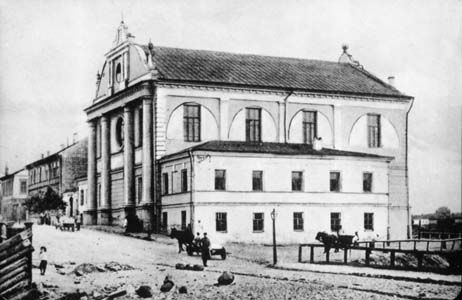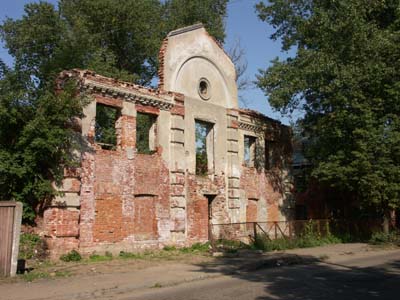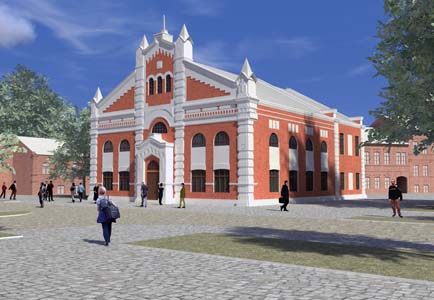

Project «Voices of Jewish settlements. Vitebsk region.»פיתוח קשרי התרבות בין העמים של ישראל ובלרוס
|
|---|
Website search |
|
MainNew publicationsContactsSite mapVitebsk regionMogilev regionMinsk regionMikhail Rivkin, Arkady Shulman
|
FROM THE HISTORY OF VITEBSK SYNAGOGUES Main Choral synagogue in Malo-Mogilevskaya Street.
Main Choral synagogue in Malo-Mogilevskaya Street.
Studying the history of Vitebsk synagogues is not so easy. At the beginning of the 20th century the city had more than 50 synagogues and prayer houses. However, the ruins of only one prayer house can be seen today. This situation can be called nothing but a cultural disaster, since synagogues are the most expressive feature of Ashkenazi culture. All the synagogues in Vitebsk were destroyed either during the last war or the Soviet regime. What is left is a few archive documents with some drawings of the buildings, several photographs in pre-revolutionary postcards and paintings of Vitebsk artists (including Mark Chagall) - these are the only sources of study.  Big synagogue in Suvorovskaya Street.
Big synagogue in Suvorovskaya Street.
Jews are first mentioned in the archives in 1551. At the end of the 18th century Vitebsk turned into one of the largest centers of Hasidism in Belarus. First Belarusian Hasidim formed a community around rabbi Mendel Vitebsky, who lived in Gorodok, 30 km away from Vitebsk. At the beginning of 1780 rabbi Shneur Zalman Borukhov was one of the most important figures in Belarusian-Lithuanian Hasidism. He was born in the place of Liozno near Vitebsk. At the age of 15 he got married and moved to Vitebsk, where he studied Talmud and lead an ascetic life. Rabbi Shneur Zalman became the founder of a new branch of Hasidism, called HaBaD. It is known that at the beginning of the 19th century there were 27 Christian churches in Vitebsk and 4 Jewish schools. It's noteworthy that in the following decades the number of Christian churches in the city did not increase, while the number of synagogues continued growing. In 1865 Vitebsk had 34 prayer houses, most of which (around 80%) belonged to Hassids. At the beginning of the 20th century the number of synagogues in town was close to 60. The synagogues in Vitebsk were mainly wooden and were not architecturally different from the rest of the town buildings. There were also a few big stone synagogues. One of them was located on the bank of the Western Dvina in Malo-Mogilevskaya Street and was the main Choral Synagogue in town. The drawings of the synagogue can be found in the National historical archive of the Republic of Belarus. No photographs of Vitebsk wooden synagogues have reached our time. Therefore, Marc Chagall, who left us a painting of one of the wooden synagogues, made a priceless contribution into the historical archives of the city. The main value of Vitebsk synagogues was its "Sfarim Torah". About 10 people were involved in their production and it took them about half a year to prepare one scroll of the Torah (about 60 meters in length). 
 Remains of the building and restoration project in Bolshaya Ilyinskaya Street.
Remains of the building and restoration project in Bolshaya Ilyinskaya Street.
Destruction of Vitebsk synagogues in the Soviet era meant the destruction of a whole layer of Jewish culture in its architectural, artistic and spiritual aspects. Today only a façade of one authentic building of a synagogue is left in Vitebsk in Revolutsionnaya (former Bolshaya Ilyinskaya) Street. Ludmila Khmelnitskaya,
|
|||
|
|
Jewish settlements in Vitebsk regionVitebsk • Albrehtovo • Babinovichi • Baran • Bayevo • Begoml • Beshenkovichi • Bocheikovo • Bogushevsk • Borkovichi • Braslav • Bychiha • Chashniki • Disna • Dobromysli • Dokshitsy • Druya • Dubrovno • Glubokoye • Gorodok • Kamen • Kohanovo • Kolyshki • Kopys • Krasnopolie • Kublichi • Lepel • Liady • Liozno • Lukoml • Luzhki • Lyntupy • Miory • Obol • Oboltsy • Orsha • Osintorf • Ostrovno • Parafianovo • Plissa • Polotsk • Prozorki • Senno • Sharkovshina • Shumilino • Sirotino • Slaveni• Smolyany • Surazh • Tolochin • Ulla • Verhnedvinsk • Vidzy • Volyntsy • Yanovichi • Yezerishe • Zhary • Ziabki • |
Main |
New publications |
Contacts |
Site map |
Vitebsk region |
Mogilev region |
Minsk region |